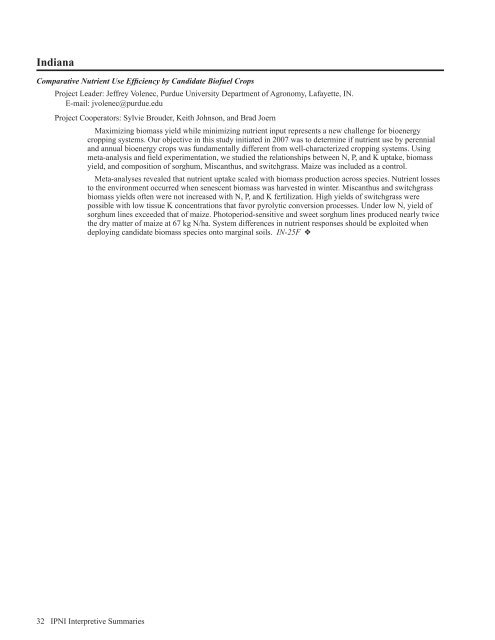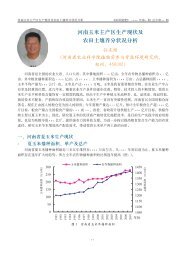Americas and Oceania Group - International Plant Nutrition Institute
Americas and Oceania Group - International Plant Nutrition Institute
Americas and Oceania Group - International Plant Nutrition Institute
Create successful ePaper yourself
Turn your PDF publications into a flip-book with our unique Google optimized e-Paper software.
Indiana<br />
Comparative Nutrient Use Efficiency by C<strong>and</strong>idate Biofuel Crops<br />
Project Leader: Jeffrey Volenec, Purdue University Department of Agronomy, Lafayette, IN.<br />
E-mail: jvolenec@purdue.edu<br />
Project Cooperators: Sylvie Brouder, Keith Johnson, <strong>and</strong> Brad Joern<br />
Maximizing biomass yield while minimizing nutrient input represents a new challenge for bioenergy<br />
cropping systems. Our objective in this study initiated in 2007 was to determine if nutrient use by perennial<br />
<strong>and</strong> annual bioenergy crops was fundamentally different from well-characterized cropping systems. Using<br />
meta-analysis <strong>and</strong> field experimentation, we studied the relationships between N, P, <strong>and</strong> K uptake, biomass<br />
yield, <strong>and</strong> composition of sorghum, Miscanthus, <strong>and</strong> switchgrass. Maize was included as a control.<br />
Meta-analyses revealed that nutrient uptake scaled with biomass production across species. Nutrient losses<br />
to the environment occurred when senescent biomass was harvested in winter. Miscanthus <strong>and</strong> switchgrass<br />
biomass yields often were not increased with N, P, <strong>and</strong> K fertilization. High yields of switchgrass were<br />
possible with low tissue K concentrations that favor pyrolytic conversion processes. Under low N, yield of<br />
sorghum lines exceeded that of maize. Photoperiod-sensitive <strong>and</strong> sweet sorghum lines produced nearly twice<br />
the dry matter of maize at 67 kg N/ha. System differences in nutrient responses should be exploited when<br />
deploying c<strong>and</strong>idate biomass species onto marginal soils. IN-25F v<br />
32 IPNI Interpretive Summaries

















